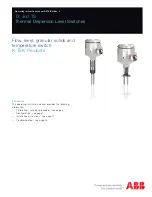
Communication Ports
4.3.3 Channel Allocations for IEEE 802.11b/g
4.3.3
Channel Allocations for IEEE 802.11b/g
The following details the channel identifiers, channel center frequencies and regula-
tory domains of each IEEE 802.11b/g 22-MHz-wide channel:
Note
Mexico is included in the Rest of World regulatory domain. However, channels 1
through 8 are for indoor use only while channels 9 through 11 can be used indoors
and outdoors. Users are responsible for making sure the channel set configuration
complies with the regulatory standards of Mexico.
Regulatory Domains
Channel
Identifier
Frequen-
cy(MHz)
America (-A)
EMEA (-E)
Japan (-J)
Rest of
World (-W)
1
2412
●
●
●
●
2
2417
●
●
●
●
3
2422
●
●
●
●
4
2427
●
●
●
●
5
2432
●
●
●
●
6
2437
●
●
●
●
7
2442
●
●
●
●
8
2447
●
●
●
●
9
2452
●
●
●
●
10
2457
●
●
●
●
11
2462
●
●
●
●
12
2467
●
●
●
13
2472
●
●
●
2484
●
Not supported in Japan for 802.11g mode.
4.4
EoVDSL Ports
Ethernet over VDSL (EoVDSL) connections operate in pairs with one device config-
ured as the Master and the other as the Slave. In VDSL (Very-high-bit-rate Digital Sub-
scriber Line), the terms Central Office (CO) or Line Termination (LT) are used inter-
changeably for the Master, and the terms Customer Premise Equipment (CPE) or Net-
work Termination (NT) are used interchangeably for the Slave. All EoVDSL line con-
figuration settings are modified on the Master and pushed to the Slave. Data flowing
from the Master to the Slave is designated
downstream
, while data flowing from the
Slave to the Master is designated
upstream
.
Siemens supports two types of EoVDSL:
•
Universal EoVDSL
Universal EoVDSL ports are Master/Slave selectable and offer symmetric data
rates (upstream and downstream) up to 35 Mbps. They are best suited for higher
throughput connections spanning distances up to 2.5 km (1.6 mi).
RUGGEDCOM RS930W
Installation Manual, 02/2020, C79000-G8976-1035-07
25
















































